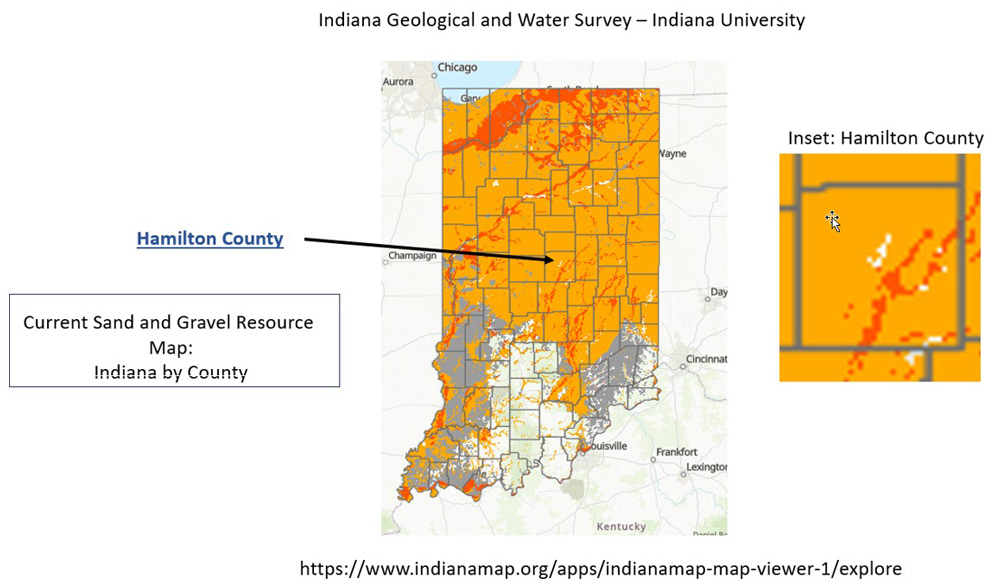Letters to the Editor do not reflect the opinions of The Reporter, its publisher or its staff. You can submit your own Letter to the Editor by email to News@ReadTheReporter.com. Please include your phone number and city of residence. The Reporter will publish one letter per person per week.
Dear Editor:
1.) The proposed Noblesville variance for a “new” gravel pit on the west side of Cherry Tree Road is being proposed in a residentially zoned R1 area/neighborhood by Chris Beaver and Beaver Materials.
2.) It will literally be in the backyards of residential homes/businesses with some gravel pit boundaries reported as close as 16 feet from residential property lines.
3.) The Beaver proposed variance violates Noblesville’s Comprehensive Plan, which was paid for by citizen tax dollars. It is not uncommon for comprehensive plans to cost hundreds of thousands of dollars.
4.) It is highly likely it will put Cherry Wood Stables out of business after decades of its management supporting the local Noblesville community, based on expert opinion. Additionally, the highly respected Hoosier Futbol Club will be impacted.
5.) Domestic and global scientific experts have documented the health hazards associated with gravel/sand mining for decades. These include but are not limited to silicosis particulate matter found in gravel mining dust which is known to cause permanent and debilitating lung damage which can be both chronic and fatal (e.g., COPD and lung cancer) as well as other cancers.
6.) Silica tainted dust can travel for many miles and its particles are so small that it cannot be detected when it is being inhaled. It often takes many years/decades for the impact of silica dust to become evident (e.g., longer than 20 years). This information is well documented in easily searched in scientific medical literature.
7.) While residents have been told by President Chris Beaver that there will be no blasting in his variance request, Martin Marietta (MM) first gained approval of their mining operation stating the same thing. They later applied for and received blasting approval. Many area citizens have complained about their homes shaking frequently from the blasts and from the daily vibrations which occur as a result of the daily MM mining operations.
8.) Martin Marietta runs their conveyor operations well into late evening hours past their agreed “curfew” and the constant loud noise from their conveyors can be heard for long distances.
9.) Noblesville seemingly does not, as a matter of practice, consider or evaluate the impact their decisions have on local residents or businesses. The same appears to be true of Noblesville not conducting routine compliance studies of the companies they grant variances to. In other words, they may grant variances without knowing if businesses are keeping up their end of promised requirements which allowed them to get a variance in the first place.
10.) During the Grace Church public meeting, Chris Beaver stated that he will not commit to a.) not using conveyors in the future, and b.) not going back to the BZA board for additional variances (e.g., blasting) in perpetuity.
11.) During that same meeting, when Chris Beaver was asked about damage to residents’ wells, he commented that this has happened in the past and citizens can contact a government agency to get their wells fixed.
12.) When asked about damage to roads resulting from the transport of materials from his gravel pit, Mr. Beaver replied that Cherry Tree Road’s weight issues needs to be addressed by the city/county. Mr. Beaver’s cousin sits on the county council.
13.) Mr. Beaver’s overall position appears to many as being one of, “as long as I follow the regulations, that’s all I need to do.” However, mining experts argue that regulations from the “Mining Law of 1872 provides an inadequate structural framework and serves as an impediment to a robust, environmentally, and socially responsible, sustainable domestic mining industry.” (Source: doi.gov/ocl/mining-law-reform) That assessment is from the U.S. Department of the Interior. Clearly, in 1872, they did not have CAT scan machines or other instrumentation to measure lung capacity and functionality. In instances where silicosis does not exist, other lung disease can still be present including those that are fatal.
14.) Mr. Beaver has stated that he would berm/mound his Cherry Tree gravel pit to “control” dust issues. Martin Marietta has made similar statements. However, it is common knowledge that the dust from Mr. Beaver’s River Road gravel pit operation has not controlled the dust found on homes, vegetation, or River Road itself to any reasonable degree. Further, the dust from Martin Marietta’s operation has already left the air on Cherry Tree Road difficult to breath at times and a clean car can become dusty with a single drive down Cherry Tree Road.
15.) Carmel had litigation with Martin Marietta in part because of issues involving the foundation of homes sinking.
16.) Residents have been told that Beaver has to go where the sand and gravel are. This has led residents to inquire as to whether Cherry Tree Road is a singular source for needed gravel and sand. The Indiana Geologic and Water survey demonstrates that Indiana is rich throughout its borders in both sand and gravel. Clearly, Cherry Tree Road is not a single source for sand or gravel and the state’s most prolific supplies are up north. (See the graphic below.)

The dark orange traces represent current sand and gravel deposits across the Indiana and Hamilton County. (Graphic provided)
17.) The Noblesville Common Council previously voted down a Beaver Materials mining operation near Potter’s Bridge. Reportedly, the documented health concerns associated with gravel/sand pit mining was of noteworthy concern to council members. In this instance, Beaver Materials is doing an end-run around the City Council by going to the BZA (Board of Zoning Appeals) for a 10-year variance approval which could be extended.
18.) The Noblesville BZA is scheduled to make its final decision to approve or deny this proposed gravel pit on Oct. 2 at City Hall. Three of the BZA members are appointed by the mayor; two are not.
19.) Mr. Beaver does not own the land on Cherry Tree Road that he is seeking to mine.
Key question: If Noblesville’s BZA Board members approve Beaver Materials Cherry Tree Road proposed mining operation on Oct. 2 and ignore the health and wellbeing of resident on many fronts including but not limited to a.) lung damage, b.) exposure to carcinogens, c.) water well damage and/or contamination d.) citizen out-of-pocket expenses resulting from Beaver Materials mining operation e.) home value depreciation, f.) constant untenable noise levels from gravel trucks, conveyors, etc., g.) homes, vehicles, and vegetation constantly being covered in dust, etc. – do you think they or any of Noblesville’s political leaders will hesitate putting a gravel pit in YOUR backyard and putting you and YOUR family’s health, quality of life, and home investment at risk?
Gail King
Noblesville


The odds of a Democrat getting elected in Hamilton County is slim to none but it doesn’t hurt to think that day may come.
First off, I could care less if this gets approved or disapproved, I moved away years ago. I still have family in the area and follow local news. After reading everything that’s been posted on this topic, the people posting most of this nonsense need an education in facts not assumption. 1. Silica in natural sand from Indiana is almost unmeasurable. The same sand is used on artificial beaches, sandboxes, playgrounds, baseball turf mixes, etc safely. More silica gets put in the air when farmers till a dry field. 2. A gravel pit is not the same as a limestone quarry. Extraction methods between the two are completely different. Learn the difference, its hugely important. 3. Gravel pits don’t affect the water table. Stone quarries, however, do harm the water table. Stone quarries pump the water below the Extraction area which may be several hundred feet below the surface. Gravel pits may actually help increase the water table supply. Dnr has a well protection division that will monitor well levels free and force responsibility if one goes dry. 4. The mining law of 1872 was only the first of many acts. Msha 30cfr parts 56/57 clearly state federal limits for particulate matter in the air and their limits. 30cfr is constantly updated.
The majority of gail kings letter to the editor is an exaggeration of information related to limestone quarries, not Gravel pits or flat out assumptions
Using the words ‘DNR’ & ‘forcing responsibility’ in the same sentence indicates a profound lack of understanding.